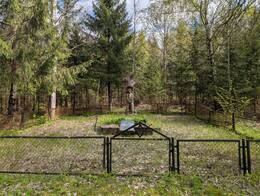Massacre of Jewish women from Salantai in the Šateikiai Forest
In the summer of 1941, a massacre of Jewish women and children was carried out in the Šateikiai Forest, organized by the local police and white-robed militia. The victims were transported to the site of the massacre from Salantai, and before being shot, they were ordered to undress and jump into a dug pit. According to different sources, from 95 to 230 people were killed during these executions, mostly women and girls.
: "A week after the shooting of the Salantai men, the police chief P. Baltuonis received an order to shoot Jewish women. The shooting was planned to be carried out in the Šateikiai forest. P. Baltuonis ordered C. Skridaila to ensure the security of the massacre site. He instructed the elder to assign carters from the villages to transport the women to the shooting site. About 10-12 white-robed soldiers from the Salantai unit left for the Šateikiai forest at midnight. The Šateikiai white-robed soldiers were waiting for them there, having prepared a large pit for the massacre. According to the police instructions, carters who arrived from the villages with horses went to the synagogue. From there, over 60 Jewish women and children were taken out. The column drove to the massacre site. The shooting began at dawn and took place in the same order as the carts with condemned Jews arrived in the forest. Before the shooting, the women were ordered to undress and jump into the The executioners standing on the edge of the ditch would shoot the lying women and children.
The exact date of the shooting is not known. Some witnesses claim that it took place in mid-July (around the 20th). Around mid-July 1941, young Jewish women and girls from Salantai were driven to the Šalynas manor, where they worked in the fields. A month later (at the end of August 1941), they were driven to the Šateikiai forest and shot there. A total of 35 women and girls were killed.
Related timeline
Related objects
Graves of Holocaust victims in Šateikiai
The site and grave of the massacre of women and children of the Salantai Jewish community is a historical cemetery of Holocaust victims in the northwestern part of the territory of the Plungė district municipality, in Šateikiai Rūdaičiai (Plateliai eldership), 0.5 km northeast of the Skuodas-Klaipėda road, on the northwestern edge of the Šateikiai forest.
The gravesite is rectangular in plan, 10 x 10 m in size, surrounded by a wire mesh fence. In its northwestern part, there are metal, openwork, single-leaf gates, the upper part of which depicts the Star of David. The Star of David and a memorial inscription in Yiddish and Lithuanian are carved on the monumental granite slab. In 1980, a wooden sculpture depicting a standing Jew with his hands tied was erected (author - folk artist Jakovas Bunka). The area of the territory is 0.01 ha.
In this place, in July–August 1941, auxiliary policemen from Salantai and Šateikiai killed women and children of the Salantai Jewish community. The execution took place in three stages. The first massacre took place around July 20, 1941. On the orders of the police, carters with carts arrived from the villages at dawn near the Salantai synagogue, where Jewish women and children were being held, and, accompanied by auxiliary policemen, took about 60–70 women to Šateikiai Forest. During the second massacre, at the end of July, the last remaining women and children in the ghetto were killed, more than 50 of them. At the end of August, auxiliary policemen escorted about 100 Jewish women from Salantai to Šateikiai Forest for execution. Since July, they had been working as auxiliary agricultural workers at the Šalynas Manor and with farmers in the Salantai Rural Municipality.
According to the Holocaust Atlas in Lithuania, 95 victims are buried here. The memorial plaque at the gravesite and the document collection "Mass Massacres in Lithuania" indicate that 100 Jewish men, women and children were killed here. Paulius Vaniuchinas, a researcher of the history of Salantai, determined that 210–220 women and children were killed at this site.
The site of the massacre and burial was declared a historical monument of local importance in 1970 and registered in the register of cultural heritage in 1993.





